| 4.2. Ausrichten | ||
|---|---|---|

|
4. Transformationswerkzeuge |  |
The Align tool is useful to align the image layers with various image objects. When this tool is selected, the mouse pointer turns to a small hand. By clicking on an element of a layer in the image, you choose the layer which will be moved (with Shift + click, you can choose several layers to be aligned); this focused layer has small squares in corners and is called source. Then buttons in the dialog become active (they remain active during all the GIMP session): they allow you to select the target, i.e other layer, selection, path, the source will be aligned with.
Sie haben verschiedene Möglichkeiten, Ausrichten zu aktivieren:
über das Menü → → im Bildfenster,
by clicking on the tool icon:
![]() in the toolbox,
in the toolbox,
über das Tastenkürzel Q.
Bei gedrückter Umschalt-Taste können Sie mehr als eine Ebene auswählen.
![[Tipp]](images/tip.png)
|
Tipp |
|---|---|
|
Sie können mehrere Ebenen auch einfach mit der üblichen »Gummiband«-Funktion auswählen: Klicken Sie außerhalb der anvisierten Ebenen ins Bild und ziehen Sie die Maus so, dass sich alle betreffenden Ebenen innerhalb des entstehenden rechteckigen Bereichs befinden. Wenn Sie jetzt die Maustaste loslassen, werden alle eingeschlossenen Ebenen ausgewählt. Beachten Sie, dass es hier kein »erstes Objekt« als Ziel gibt, an dem die ausgewählten Ebenen ausgerichtet werden können. |
Normalerweise werden die aktuellen Einstellungen eines Werkzeugs unterhalb des Werkzeugkastens angezeigt, sobald Sie ein Werkzeug aktivieren. Falls das nicht der Fall ist, können Sie sie jederzeit über → → im Bildfenster aktivieren.
In this drop down list, you select the target, the image object the layer will be aligned with.
Erstes Objekt: die erste von mehreren bei gedrückter Umschalt-Taste ausgewählten Ebenen. Wenn Sie mit Hilfe der Gummiband-Funktion mehrere Ebenen auswählen, gibt es allerdings kein »erstes Objekt«.
Image: the image is the target.
Selection: the selection is the target.
Active layer: the active layer, in the layer dialog, is the target.
Active Channel: the active channel, containing a selection you made before, is the target.
Active Path: the active path is the target.
Diese Knöpfe werden verfügbar, sobald ein Ziel ausgewählt wurde.
 : to
align left edge of source with left edge of target.
: to
align left edge of source with left edge of target.
 : to
align center of source on the
vertical middle line of target.
: to
align center of source on the
vertical middle line of target.
 : to
align right edge of source with right edge of target.
: to
align right edge of source with right edge of target.
 : to
align top edge of source with top edge of target.
: to
align top edge of source with top edge of target.
 : to
align center of source on the
horizontal middle line of target.
: to
align center of source on the
horizontal middle line of target.
 : to
align bottom edge of source with bottom edge of target.
: to
align bottom edge of source with bottom edge of target.
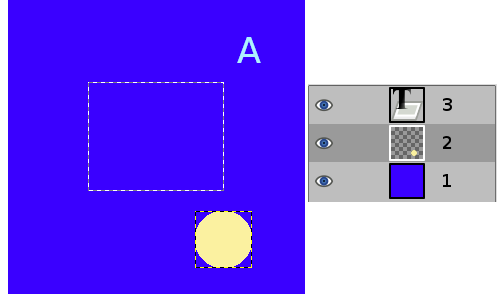
An image with a selection, layer #1 (background) is active, layer #2 is cropped to content, layer #3 is a text layer.
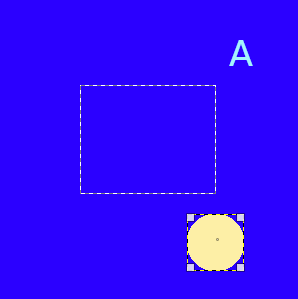
We click on the yellow circle: layer #2 becomes the source. We want to send this source to the middle of the selection: the Relative to option is set to „Selection“.
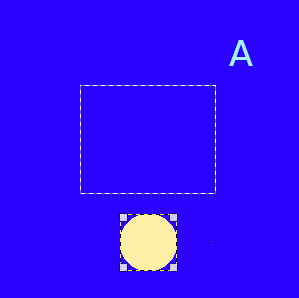
clicked

clicked
These options are used when you have several targets and want to arrange them. Here, layers selected with Shift + Click are called „targets“ . But they are actually sources. „Relative to“ options are active to set the target. These transformations are usually relative to „Image“.
These options work as Align options, but you can add an offset and new options are available to distribute sources evenly.
 : to distribute left edges of sources
on the left edge of the target (the image).
: to distribute left edges of sources
on the left edge of the target (the image).
 : to distribute centers of sources
with center of the target horizontally.
: to distribute centers of sources
with center of the target horizontally.
 : to distribute right edges of
sources on right edge of the target.
: to distribute right edges of
sources on right edge of the target.
 : to distribute sources evenly
horizontally.
: to distribute sources evenly
horizontally.
 : to distribute top edges of sources
on top edge of target.
: to distribute top edges of sources
on top edge of target.
 : to distribute centers of sources
with center of target.
: to distribute centers of sources
with center of target.
 : to distribute bottom edges of
sources with bottom edge of target.
: to distribute bottom edges of
sources with bottom edge of target.
 : to distribute sources evenly
vertically.
: to distribute sources evenly
vertically.
This offset can be positive or negative and is expressed in pixels. Distribute add it to the left edges, horizontal centers, right edges, top edges, vertical centers, or bottoms of sources.
Abbildung 14.121. Beispiel für Befehle von »Verteilen«
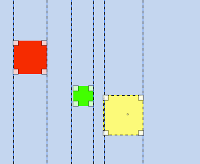
Ausgangsbild: Drei Ebenen.  (Rechte Kanten der Ziele verteilen) wird verwendet.
(Rechte Kanten der Ziele verteilen) wird verwendet.
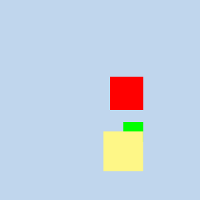
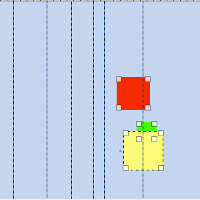
GIMP-2.10 shows relative coordinates (horizontal or vertical) when moving guides and sample points. Coordinates are relative to the start of moving.

Abbildung 14.122. Original
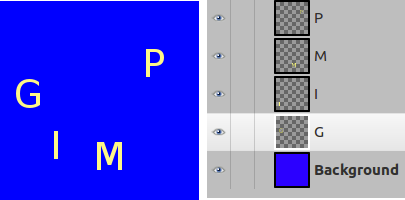
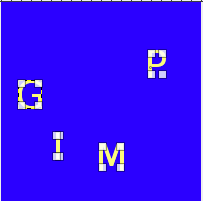
We select them as sources with Shift + Click.
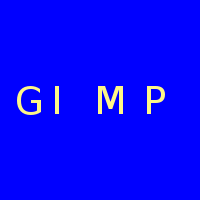
The default target (Relative to) is
„Image“. Offset = 0. We used the
 (Distribute vertical centers of targets) command.
(Distribute vertical centers of targets) command.
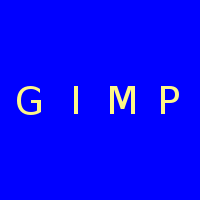
Nach Verwendung von  (Ziele gleichmäßig horizontal aufteilen) mit Versatz = 5.
(Ziele gleichmäßig horizontal aufteilen) mit Versatz = 5.
Abbildung 14.123. Ausrichten mit Gummiband
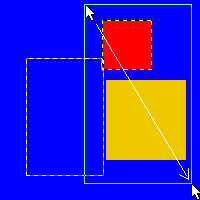
Nach einem Mausklick links oberhalb der roten Ebene wird die Maus nach rechts unten gezogen, so dass beide Ebenen eingeschlossen sind.
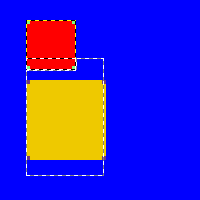
Referenz der Ausrichtung ist »Auswahl«. Ein Klick auf  , und beide Ebenen werden an der linken Seite des Auswahl ausgerichtet.
, und beide Ebenen werden an der linken Seite des Auswahl ausgerichtet.